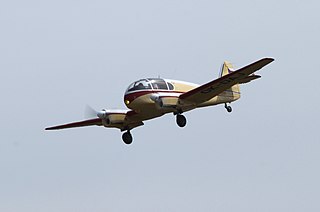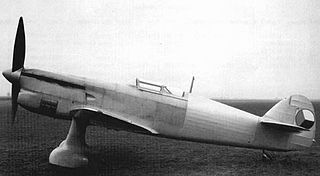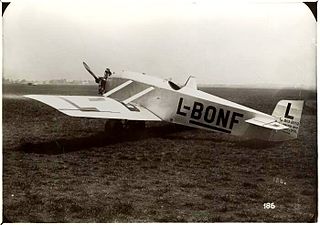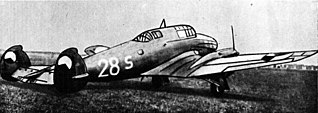
The Aero 45 was a twin-piston engined civil utility aircraft produced in Czechoslovakia after World War II. Aero Vodochody produced the aircraft in 1947–1951, after which the Let Kunovice rolled out these planes until 1961. In 1958 the Ae-45S became the first Czechoslovak plane to cross the Atlantic Ocean. It was the first product of the nation's postwar aviation industry and proved a great success, with many of the 590 produced being exported.

The Aero A.100 was a biplane light bomber and reconnaissance aircraft built in Czechoslovakia during the 1930s. It was the final step in a design lineage that extended back to the Aero A.11 a decade earlier. A.100s remained in service throughout World War II and for a few years postwar.

The Avia BH-21, first flown in 1925, was a robust biplane that served an important role in securing Czechoslovak national security during the period between World War I and World War II. As well as being a competent fighter, it was also an accomplished racer, winning several air races in 1925.

The Avia B.35 was a fighter aircraft built in Czechoslovakia shortly before World War II.

The Avia B.135 was a Czechoslovak cantilever monoplane fighter aircraft. It was the production version of the Avia B.35 developed shortly before the war, based on the B.35/3 prototype but featuring a new all-metal wing.

The Avia BH-1 was a two-seat sports plane built in Czechoslovakia in 1920. It was the first product of the Avia company, and it was originally designated BH-1 exp. The BH-1 was a low-wing braced monoplane of wooden construction, with tailskid undercarriage. Power was provided by a Daimler engine, which proved inadequate to fly the aircraft with both seats occupied.

The Avia BH-3 was a fighter plane built in Czechoslovakia in 1921. Conceptually a descendant of the BH-1 sports plane, it was a braced, low-wing monoplane of conventional configuration and tailskid undercarriage. Following favourable trials in June 1921, ten examples were ordered by the Czechoslovakian Air Force. These were delivered in 1923 under the military designation B.3. The type proved temperamental in service and was soon relegated to training duties, where it served until 1927.

The Avia BH-6 was a prototype fighter aircraft built in Czechoslovakia in 1923. It was a single-bay biplane of unusual configuration, developed in tandem with the BH-7, which shared its fuselage and tail design.

The Avia BH-7 was a prototype fighter aircraft built in Czechoslovakia in 1923. It was a parasol-wing monoplane developed in tandem with, and as an alternative to the BH-6, which shared its fuselage and tail design. Like the BH-6, the BH-7 was involved in a number of serious crashes during its test programme, which led to its abandonment as a fighter. Undaunted, however, Avia used the design as the basis for a racing aircraft, shortening the wingspan by 1.4 m, fairing the wing directly onto the top of the fuselage and dispensing with the cabane struts. This revised version was designated BH-7B and the fighter (retrospectively) as the BH-7A. When the design proved no more successful as a racer, it was finally put to rest.
The Avia BH-8 was a prototype fighter aircraft built in Czechoslovakia in 1923. It was an unequal-span biplane developed on the basis of the ill-fated BH-6 design, in an attempt to address that type's problems. It shared the BH-6's unusual wing cellule design.

The Avia BH-9 was a twin-seat sports plane built in Czechoslovakia in 1923, based on the BH-5. As with other developments in the BH-1 lineage, the BH-9 was a low-wing braced monoplane that accommodated the pilot and passenger in tandem, open cockpits. The BH-9's structure was strengthened to allow the use of a higher-power engine than in its predecessors, and for the first time, this was a domestically-produced powerplant. Although built as a twin-seat aircraft at least one was converted to a single-seater.

The Avia BH-11 was a two-seat sport aircraft built in Czechoslovakia in 1923, a further development of the Avia BH-9. The main changes in this version involved a redesign of the forward fuselage. 15 examples were ordered by the Czechoslovakian Army as trainers and general liaison aircraft, and operated under the military designation B.11.

The Avia BH-12 was a two-seat sport aircraft built in Czechoslovakia in 1924, the final development of the Avia BH-9 family that had its roots in Avia's first aircraft design, the BH-1. It was a low-wing, braced monoplane intended for sports flying, and featured a redesigned wing that could be folded to allow the aircraft to be towed by road. The wing pivoted around its spar and then folded back, flat against the fuselage sides.

The Avia BH-16 was a single-seat very light sport aircraft built in Czechoslovakia in 1924. Like other early Avia designs, it was a low-wing braced monoplane of wooden construction. It could be powered by either a 12 kW (16 hp) four-cylinder Vaslin engine or a 19 kW (26 hp) inverted-V twin-Blackburne Tomtit.
The Avia BH-17 was a biplane fighter aircraft built in Czechoslovakia in 1924. It was a development of the BH-6 and BH-8, and work on the latter aircraft was cut short in favour of this one. Operational trials in 1924 revealed performance good enough for the Czech Air Force to place an order for 24 examples. In actual service, however, the BH-17 proved unreliable and was soon withdrawn.
The Avia BH-19 was a fighter aircraft built in Czechoslovakia in 1924. It was a low-wing braced monoplane derived from the Avia BH-3 and reflected its designers' ongoing belief that the monoplane configuration was the most suitable for a fighter aircraft. Initial trials revealed excellent performance, but also displayed control problems and aileron flutter. Nevertheless, the Czechoslovakian Army was sufficiently impressed to inform Avia that it would order the BH-19 if the problems could be rectified. The first prototype was destroyed in a crash during speed trials, and the second prototype revealed no better handling than its predecessor. At this point, the Czechoslovakian War Ministry stepped in and asked Avia to cease its attempts to develop a monoplane fighter.

The Avia BH-26 was a two-seat armed reconnaissance aircraft built in Czechoslovakia in 1927. It was a single-bay unstaggered biplane with equal-span wings and a fixed tailskid undercarriage. Both upper and lower wings featured long-span ailerons, which were dynamically balanced by a small auxiliary airfoil mounted to the upper surface of the lower ailerons. Its design was typical of this type of aircraft built during World War I and the years following; pilot and observer sat in tandem open cockpits with the observer armed with a machine gun on a ring mount. As with many other Avia designs, the BH-26 originally had no fixed fin, only a rudder, but this was changed in service.

The Avia BH-33 was a biplane fighter aircraft built in Czechoslovakia in 1927. It was based on the BH-21J which demonstrated promising results by combining the original BH-21 airframe with a licence-built Bristol Jupiter radial engine. Other than the peculiar Avia hallmark of having an upper wing with a shorter span than the lower, it was utterly conventional, even featuring a tail fin for the first time in a Pavel Beneš and Miroslav Hajn design.

The Avia B.158 was a prototype Czechoslovak twin-engined light bomber aircraft of the 1930s. Only a single example was built and it was abandoned, following the German occupation of Czechoslovakia in March 1939.

The Avia 51 was a 1930s Czechoslovakian six-passenger commercial transport, designed by Robert Nebesář and built by Avia. The type was uneconomical in use and only three were built.

















